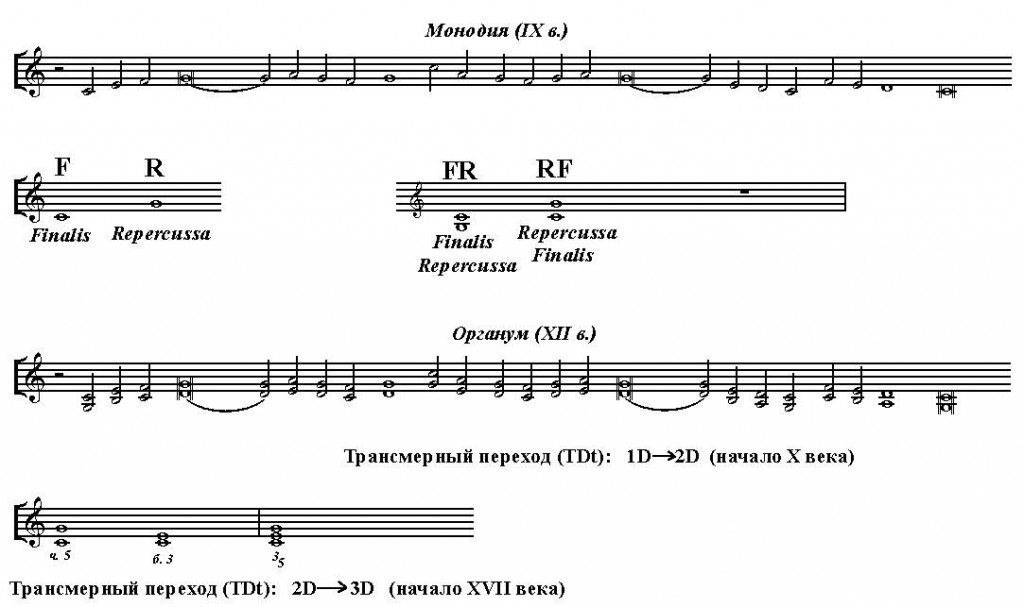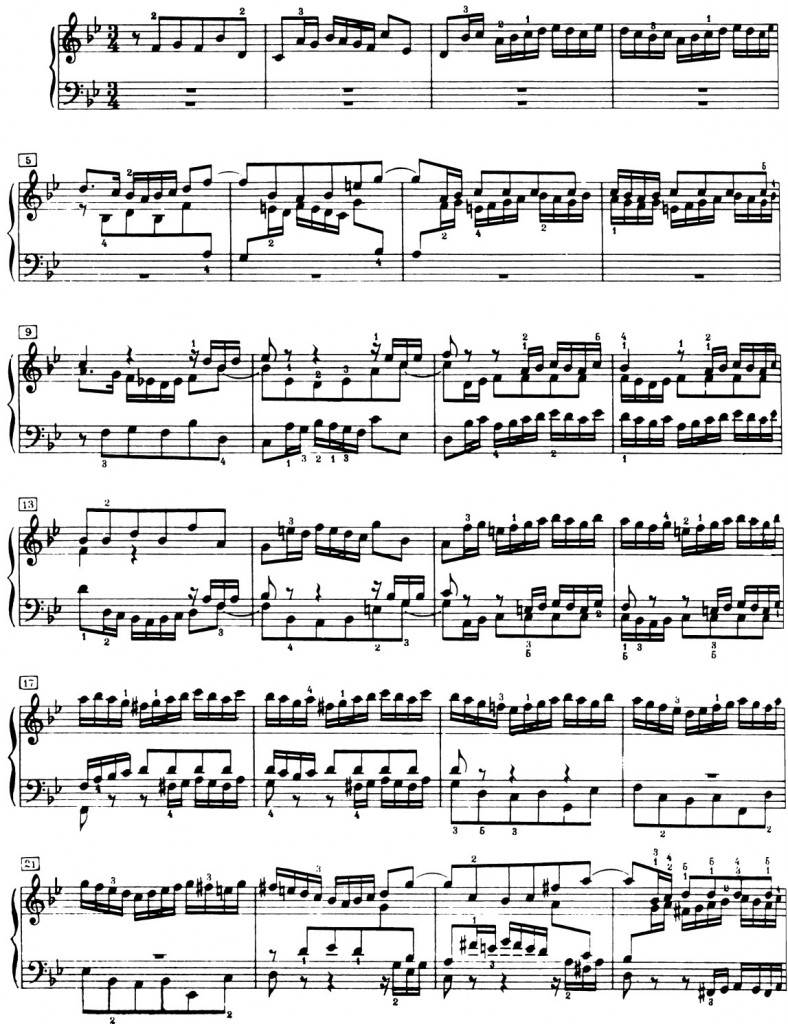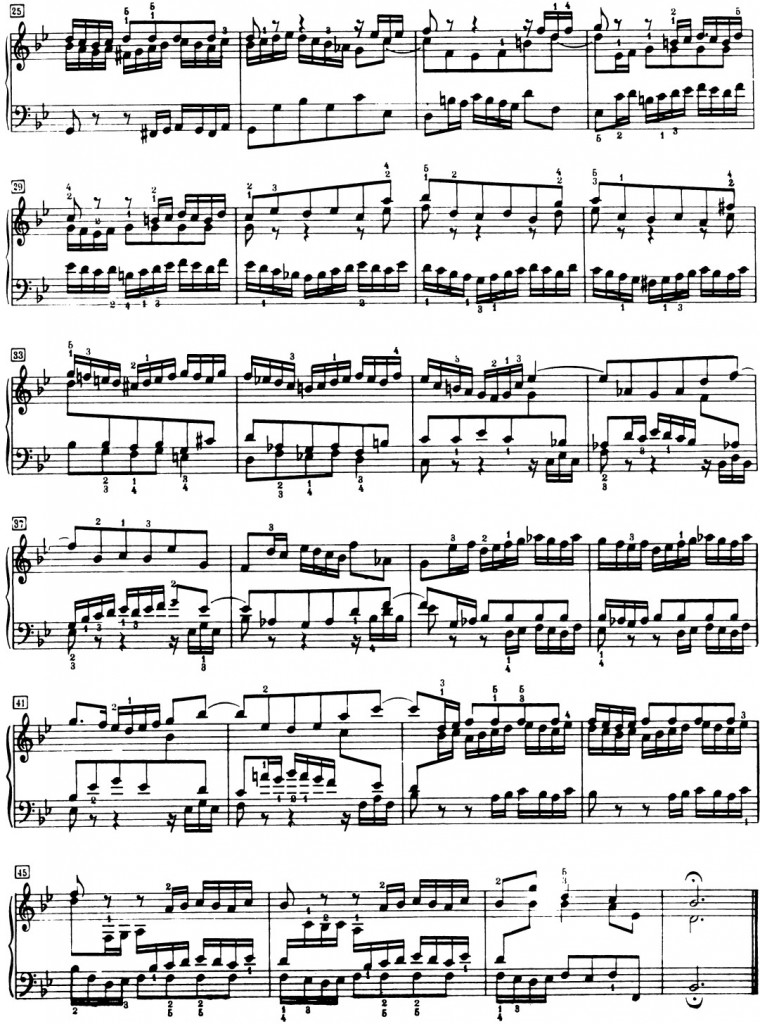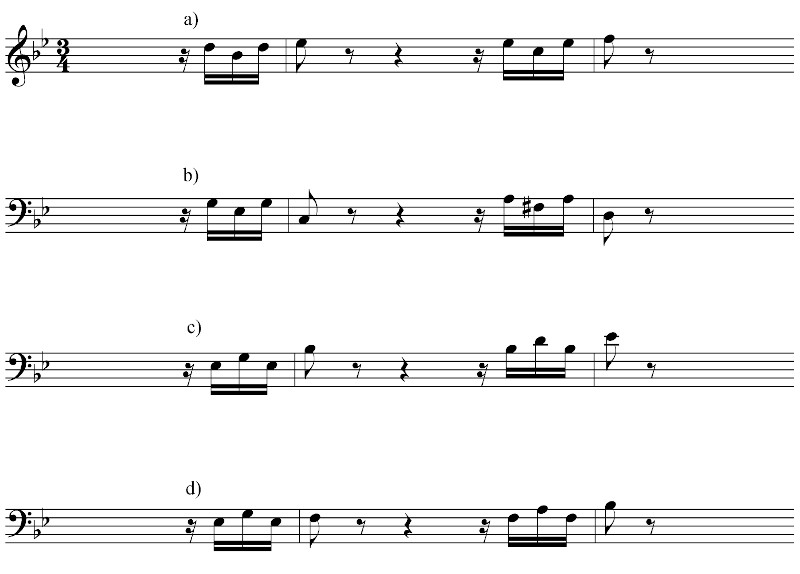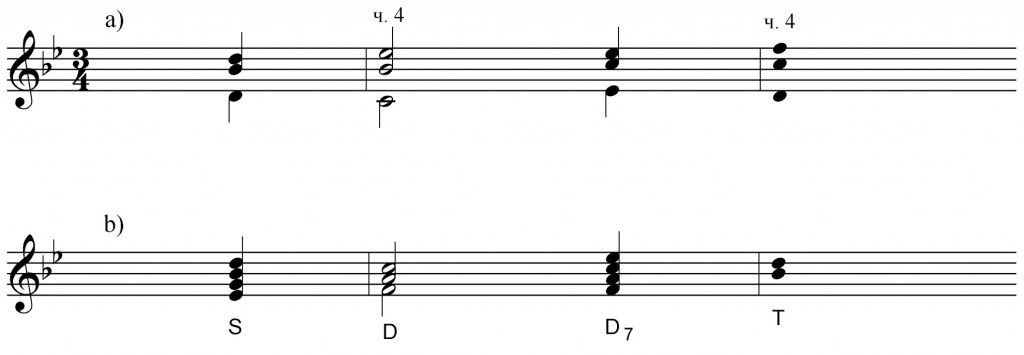The link between music and symmetry is well known. Transdimensional relations and polydimensionalism allow one to see in a new light the pair «symmetry-asymmetry». Symmetry is the unity of preservation and change. Transdimensionalism expands the very term «change»: a change in the same dimension of musical space is now complamented by the change in the dimension of that space (transdimensional transition). Another attribute of symmetry is «preservation», which also becomes more complex. Polydimesionalism expands the term «invariance», since now one is taking into account the contextual links of an object (a single melody, removed from its polyphonic or harmonic context, is simultaneously «the same» and «different»!). The connection of transdimensionalism and symmetry («transdimensional symmetry») allows us to see a new quality (parameter) that appears during the formation of the whole.
Let us look at the same pair, «stable sound-unstable sound» in the space of language. Here it is also polydimensional. From one side, both units in the pair are equal and symmetrical, differentiated only by the plus and minus signs (or by «color»). From the other side, the word «un» (negation) creates a new quality (or parameter): not only the negation of a statement («stable sound»), but also an unbreakable bond with it (since we are talking about negation not in the abstract, but of a specific statement). As a result, we find that negation is a complex unit of the pair, as apposed to the simple statement. From this point of view, the pair is polydimensional (PD=1D: 2D) and asymmetrical. Out of this, all of the pairs, which are associated with negation, are polydimensional and asymmetrical (truth-untruth, to be-not to be, etc.). The second units (context dependent) of these dyads form a pair that is «linkage» with the first units (context independent). The pair «symmetry-asymmetry» is also polydimensional!
As we all know, our thinking is based on binary oppositions, which are considered as symmetrical. As it turns out, oppositions can be simple and complex (context dependent), and complex oppositions are asymmetrical! This includes not only pairs with negative, but also with reflexive units (object-subject, action-observation), a secondary action (stimulus-reaction, vibrator-resonator), synthesis inside one of its parts (horse-rider), etc.
All of these are examples of PD of the type 1D:2D or «transdimensional asymmetry». From this we get several important logical consequences. Firstly, context-independent terms are separated from context dependent ones; in particular, we find the polydimensionality (which was not so obviously till now) of logical pairs such as «yes-no», «true-false», etc. Secondly, when one takes into account transdimensional relations and polydimensionality, classical paradoxes cease to be paradoxical. For example, “the barber paradox” (Bertrand Russell): all inhabitants of the village are context-independent (1-dimensional), while the barber is polydimensional, PD=1D:2D. The king’s order does not take this into account, thereby creating a paradox! (We can also consider other paradoxes such as «I am lying» or «I am asleep, etc.).
Here arises the possibility of creating a new type of logic — the «logic of creativity»-, which integrates classical and non classical logic into a single whole through the use of PD=1D: 2D
Let’s move on to information theory, the basic cell of which is a «bit», that is the same pair as «yes-no», or 0 and 1. It was previously thoughtthat the membersof the pairare equal andsymmetrical. However, this is only partly true. The negation «no» forms a «linkage state» with the affirmation, which justifies the transition to Q-bits. Let us remember, that the idea of Q-bits came from the physical sciences (“entanglement” in quantum mechanical terms). We arrived at the idea from studying the humanities, which underscores the universality of these new relations.
Application
ex.1
Conjunction Disjunction
Connection Statement Separation Statement
ex.2 (a, b, c, d, e)
ex.3
ex. 4
Transdimensional transition (TDt)- a transition from one dimensional space to another dimensional space.
Polydimensionality (PD) — the simultaneous presence of an object in different dimensional spaces.
Isodimensionality (ID) — the presence of an object in the same dimensional space.
Transdimensional “cascade” (TDc) — the transition from one dimensional space to another, followed by a return to the initial dimension.
Variational dimension — a space with dimensional variation.
Transdimensional “cross” - the linking of a transdimensional horizontal line with a transdimensional vertical line.
Transdimensionalism- refers to the entire set of relationships between spaces of differing dimensions within a multidimensional whole, i.e.: insertion, mutual reflection, folding-unfolding, connections between dimensions, transition from one dimension to another etc.
ex.5
B flat-major fugue by Bach,
from the first volume of Well-Tempered Clavier
ex.6
ex.7
Literature
1. Beskova I.A. How is Creative Thinking Possible. Moscow, 1993 In Russian
2. Vygotsky L.S. The Psychology of Art. Moscow., 1997 In Russian
3. Levi-Strauss K. Structure and Form. // International studies on the Semiotics of Folklore. Moscow., 1985
4. Propp V.Y. The Morphology of Tales. Moscow., 1969 In Russian
5. Sosnin E.A. Poyzner B.H. A Laser Model of Art. Moscow., 1997 In Russian
6. Chugaev A. Special Structural Traits of Bach’s Clavier Fugues. 1975 In Russian
7. Riemann H. Handbuch der Fugen-Komposition (Analyse von J.S. Bachs «WK»…) Berlin 1920
8. Koblyakov A.A. Bach’s Fugues From the Point of View of a Problem-Essence Oriented Approach // The History of Musical Education as a Science and a Curricular Subject. Moscow, 1999. In Russian
9. Koblyakov A.A, Synergy and Art: A Universal Model of Eliminating Contradictions as a New Strategy of Study // The Synergetic Paradigm, Moscow, 2000
10. Koblyakov A.A. From Disjunction to Conjuction (The Contours of a new theory of Art) // Languages of Science — Languages of Art. Moscow, 2000 In Russian
11. Koblyakov A.A. The Theorum of Transdimensional Transition // The Works of the International «Mathematics. Computers. Education» Conference Moscow-Dubna, 2000. In Russian
12. Koblyakov A.A. The Discrete and Continuous in Music from the Point of View of a Problem-Essence Oriented Approach // The Works of the International «Mathematics and Art» Conference. Moscow, 1997. In Russian
13. Koblyakov A.A. On the Single Model, Explaining Art in it’s most Broad Understanding // “Stable Development, Science and Practicem”, No. 2, Moscow-Dubna, 2003.
14. Koblyakov A. Semantic aspects of self-similarity in music // Symmetry: Culture and Science, Volume 2, Number 2. Whashington, 1995.
15. Nalimov V.V. The Spontaneity of Consciousness. Moscow, 1989. In Russian

